A Comprehensive Guide to Clipping Parrot Nails
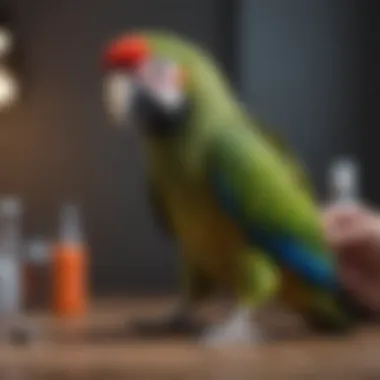
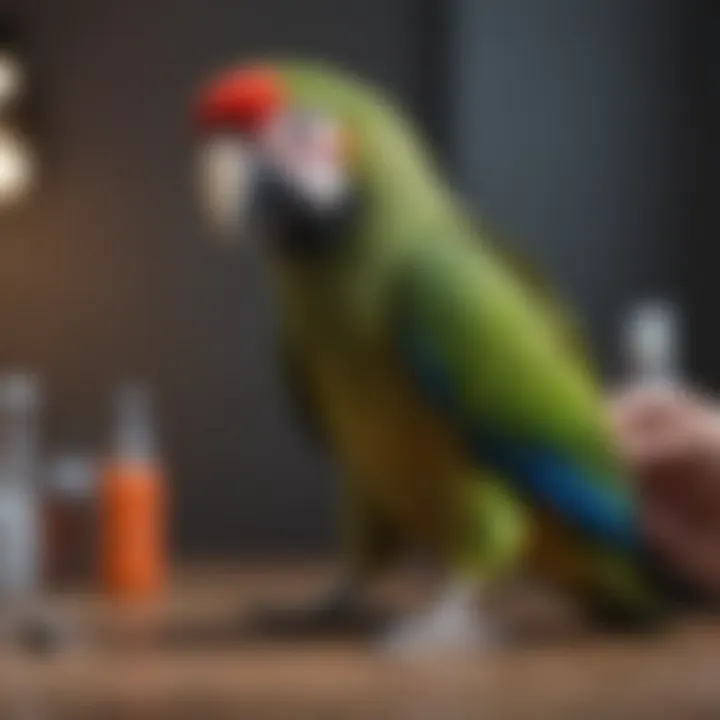
Intro
Clipping a parrot's nails is more than just a grooming task; it is a crucial aspect of responsible pet ownership. Parrots, as intelligent and playful creatures, require specific care to ensure their overall health and well-being. Neglecting their nail care can lead to discomfort, mobility issues, and potential injury.
Understanding the unique needs of your bird is vital in this process. A well-groomed parrot not only looks better but also feels better. This guide aims to provide comprehensive insights into the techniques and tools necessary for safe and effective nail clipping.
Understanding Your Pet
Pet Behavior Basics
Parrots display a range of behaviors that can influence how they react to nail clipping. For instance, certain species might be more skittish than others. Knowing your parrot's temperament aids in choosing the right approach for nail maintenance. Pay attention to their body language; a relaxed bird is less likely to resist the clipping process.
Common Breed Characteristics
Different parrot breeds exhibit distinct characteristics. For example, Cockatiels are generally sociable and adapt well to handling, while African Greys can be more reserved. Understanding these traits helps in developing a strategy tailored to your bird. Knowing these aspects leads to a more conducive environment for grooming.
Species-Specific Needs
Every parrot species has different grooming needs based on their evolutionary traits. Larger species, like Macaws, require more robust clipping techniques due to their larger claws. In contrast, smaller breeds, like Budgerigars, need gentle handling. Being aware of these distinctions ensures that clipping is performed safely and effectively, contributing to a positive experience for both the owner and the pet.
Pet Care and Maintenance
Feeding Guidelines
Proper nutrition is foundational to your parrot's health. A balanced diet including fruits, vegetables, seeds, and pellets encourages strong nail health. Avoid feeding them unhealthy snacks, as poor nutrition can lead to weakened nails and other health issues.
Grooming Essentials
Grooming extends beyond nail clipping. Regularly check your parrot's feathers and beaks. Routine grooming reinforces trust between the bird and its owner. A calm environment during grooming sessions also makes nail clipping easier and promotes a sense of safety.
Hygiene Practices
Maintaining hygiene is crucial for preventing infections. Regularly clean your parrot's living space and ensure that their food and water dishes are spotless. A clean living environment supports overall health and can influence the condition of your parrot’s nails as well.
Training and Development
Basic Commands and Skills
Training your parrot to accept handling can ease the nail clipping process. Teach commands like "step up" to encourage positive interactions. Start with short training sessions to keep them engaged and comfortable with the idea of handling.
Behavioral Training Techniques
Utilize positive reinforcement strategies. Rewarding your parrot with treats when they behave during grooming fosters a bond and helps them associate nail clipping with pleasant experiences. Consistency is key in training.
Addressing Common Behavior Issues
If your parrot shows fear or aggression during nail clipping, consider gradual desensitization. Introduce them to grooming tools when they are calm. Over time, they will learn that these tools are not harmful, making the process smoother.
"Regular clipping prevents nail-related injuries and enhances your parrot's comfort."
Health and Wellness
Routine Vet Check-ups
Regular veterinary visits are essential for overall health maintenance. Vets can offer advice on nail care and any specific health concerns related to your parrot. Make sure to schedule check-ups at least once a year.
Vaccination Needs
Vaccinations protect against various diseases common in parrots. Consult your veterinarian for necessary vaccinations and ensure that your bird is up-to-date.
Recognizing Signs of Illness
Being observant about changes in your parrot's behavior or appearance can alert you to potential health issues. Look for signs such as lethargy, changes in appetite, or abnormal droppings. Early detection can make a significant difference.
Enrichment and Activities
Indoor vs. Outdoor Activities
Engaging your parrot in both indoor and outdoor activities enhances their quality of life. Indoor activities like puzzle toys stimulate their minds, while supervised outdoor time allows them to experience the natural environment.
Interactive Toys and Games
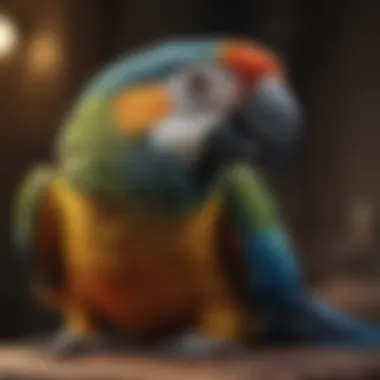
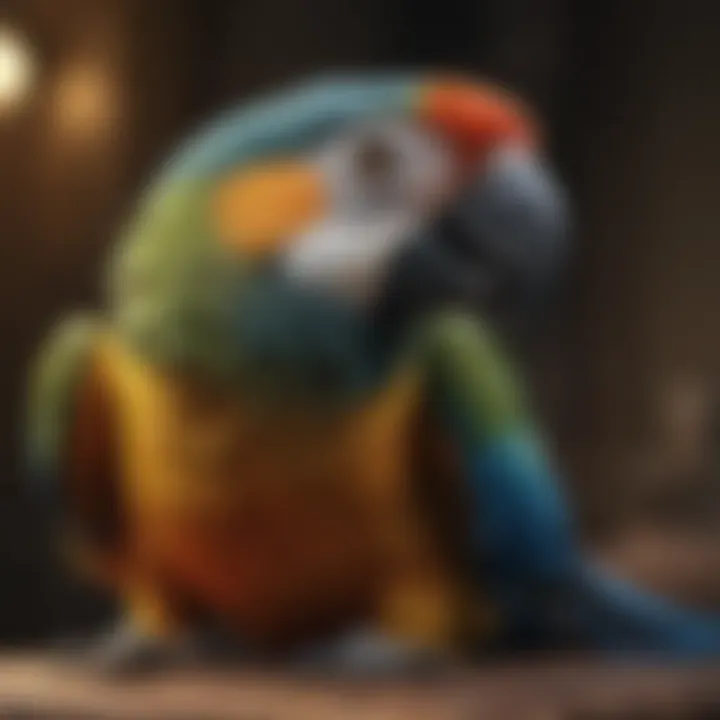
Incorporate interactive toys that challenge your parrot. Toys that encourage exploration and problem-solving can reduce stress and anxiety, making nail clipping a less traumatic experience. A happy parrot is generally more compliant during grooming.
Socialization Opportunities
Socializing your parrot with other birds or people is vital for mental stimulation. Introduce them gradually to new experiences to build confidence. This exposure helps them remain calm during nail clipping.
By understanding these aspects of parrot care, you build a solid foundation for a harmonious relationship with your pet. Clipping their nails is just one of many responsibilities, but it is crucial for their health and happiness.
Prelims to Parrot Nail Care
Maintaining a parrot's nails is not merely a matter of aesthetics; it is a crucial aspect of their overall health. Parrots, like many other birds, require regular nail care to prevent a variety of physical complications. When their nails grow too long, this can lead to pain, mobility issues, and even behavioral problems. Therefore, understanding the implications of nail maintenance is essential for parrot owners.
It is important to introduce the idea of nail clipping early during discussions about caring for parrots. Regular nail maintenance is systematic; successful practices will include learning to recognize when nails need trimming, the best techniques for safe clipping, and what tools are necessary for the task.
One might ask, what specific benefits does nail maintenance bring? Regular trimming can prevent nail breakage, which is both painful and potentially harmful for the bird. It can also facilitate better interaction between the bird and its environment, reducing the chance of the nails getting caught on objects, which is common in active birds. Additionally, unclipped nails can cause birds to feel uncomfortable when perching, ultimately affecting their mood and behavior.
The sub-aspects of parrot physiology and the significance of nail maintenance will unfold in the following sections. These areas will help establish a solid foundation of knowledge for proper nail care.
Identifying When to Clip
Understanding when to clip your parrot's nails is integral to maintaining their overall health. Regular nail care helps prevent discomfort and potential health issues that could arise from overgrown nails. Over time, neglecting this essential aspect of grooming can lead to a host of complications for your pet. Thus, discerning the right moments for nail clipping is crucial for the well-being of your feathered companion.
Assessing Nail Length
A useful initial step in determining whether your parrot's nails require clipping is consistent nail length assessment. The nails should not touch the surface when the bird stands upright. Ideally, a parrot's nails should be short enough to avoid any hindrance while climbing or perching. A clear indicator of excessive length is the nail extending beyond the quick, the pink-colored area that contains nerves and blood vessels.
To assess nail length accurately, hold your bird gently and allow it to stand on your palm or a flat surface. If the nails retract slightly or do not reach the surface, they are likely at a healthy length.
Moreover, consistency is key. Regular checks every couple of weeks can help preemptively identify issues well before they escalate.
Recognizing Signs of Overgrowth
Identifying signs of nail overgrowth in parrots is somewhat straightforward. Look for several visual and behavioral cues that indicate it's time for a trim.
Common signs include:
- Bending or curling: If the nails are curling downwards or bending at unusual angles, this is a clear signal of overgrowth.
- Difficulty grasping: If your parrot seems to struggle when attempting to grip perches or surfaces, the nails may be hampering their ability to do so.
- Excessive wear on perches: Abraded or damaged perches can indicate that your bird's nails are much too long.
- Behavior changes: If your pet displays excessive squawking or anxious behavior, it could be due to discomfort from their nails not allowing them to navigate comfortable.
It's crucial to address these signs early, as regular nail clipping not only enhances mobility but also contributes to your pet's mental well-being. By paying close attention to these indicators, you can ensure a happier, healthier life for your parrot.
Preparing for the Nail Clipping Process
Preparing for the nail clipping process is crucial for both the parrot and the owner. Each step taken prior to clipping can ensure a safer experience. Neglecting this preparatory stage can lead to stress for the bird and undesirable outcomes for the owner. By taking the time to prepare, owners can create a conducive environment and gather the right tools, making the entire clipping experience more effective.
Selecting Appropriate Tools
Choosing the right tools is fundamental in the nail clipping process. The proper equipment not only ensures efficiency but also prioritizes safety. Various tools are available on the market specifically designed for avian nail care.
- Nail Clippers: A good pair of bird nail clippers is essential. There are many types available, including scissor-style and guillotine-style clippers. Opt for sharp, high-quality clippers to make clean cuts.
- Grinders: Some owners prefer to use nail grinders rather than clippers. Grinders provide a smooth finish and reduce the risk of splitting nails. These are effective but require a gentle touch.
- Styptic Powder: Accidents can happen, even with preparation. Having styptic powder on hand can be a lifesaver. It helps to stanch bleeding if you accidentally cut too deep into the nail.
- Towels and Treats: These are important tools. A towel can be used for wrapping the parrot comfortably, while treats are essential for positive reinforcement.
Creating a Calm Environment
Establishing a calm environment can greatly enhance the nail clipping process. Parrots are sensitive creatures, and their reactions can significantly influence the experience. A serene atmosphere can reduce anxiety for both the bird and the owner.
- Choose a Quiet Space: Select a room that is free from loud noises and distractions. This may include turning off televisions or radios.
- Comfortable Positioning: Ensure the parrot is comfortable. Birds often feel secure on their owners' laps or in a familiar perch.
- Familiar Items: Surround your parrot with familiar items. Bring along their favorite toys or a blanket that they recognize. This can help to create a sense of security.
- Avoid Sudden Moves: Quick movements can startle your parrot. Approach the clipping process with slow, deliberate actions.
"Creating a serene atmosphere not only aids in a smoother nail clipping session but also significantly reduces stress levels in parrots."
Ultimately, preparing for nail clipping goes beyond tools and environment. It is about fostering a connection and ensuring the well-being of your parrot. By prioritizing preparation, owners can facilitate a calm, efficient, and safe nail clipping experience.
Techniques for Clipping Parrot Nails
Clipping parrot nails requires specific techniques to ensure safety and efficiency. This section will explore the necessary methods for holding, trimming, and managing risks during the nail clipping process. Using correct techniques is essential not only for the comfort of your bird but also to achieve effective nail maintenance.
Holding Your Parrot Safely
Properly holding your parrot is crucial when clipping its nails. A firm yet gentle grip can make a significant difference. Here are some steps to follow:
- Choose the Right Position: Sit in a comfortable chair and place your parrot on your lap or on a flat surface.
- Use Your Body as Support: Your body should provide a stable environment. You can use one arm to support your parrot's body while holding the foot with the other.
- Wrap Yours Hands: If your parrot tends to squirm, consider gently wrapping a light cloth around its body, leaving the feet accessible.
- Be Mindful of Stress: Monitor your bird's reactions. If it seems overly stressed, take a break and return to the task later.
Holding securely but gently would make your parrot feel more at ease. It reduces the chance of injury to both the bird and the owner during the procedure.
Executing the Nail Trim
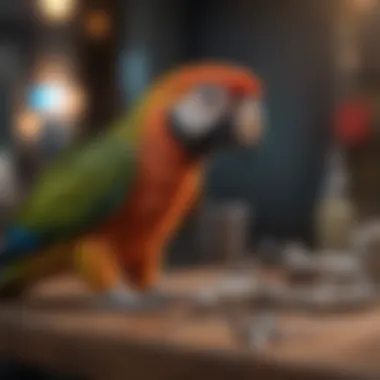
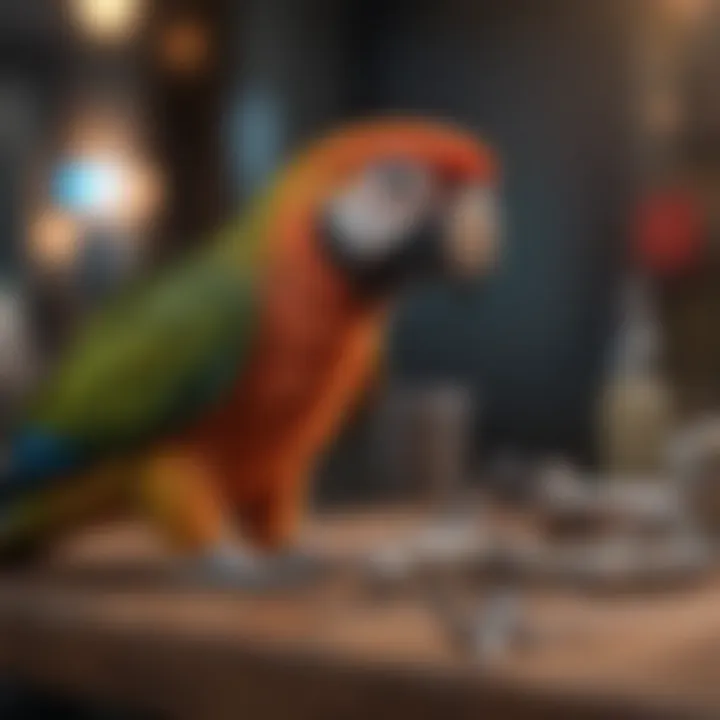
Executing the nail trim involves careful attention to detail. The following steps will guide you through the trimming process:
- Choose the Right Tools: Use a specialized bird nail clipper or a human nail clipper. Ensure they are clean and sharp.
- Identify the Quick: Before you start clipping, identify the quick, which is the blood supply within the nail. Avoid clipping into this area to prevent bleeding.
- Trim Gradually: Start with a small trim. If your bird's nails are particularly long, remove a minimal amount at a time.
- Maintain Calmness: Speak softly to your parrot throughout the process. Your voice can help soothe its anxiety.
A well-executed trim promotes nail health and comfort for your parrot.
Managing Potential Risks
Every procedure has inherent risks, especially when handling living creatures. Awareness and preparation can help mitigate these issues. Here are some essential considerations:
- Bleeding: If you accidentally cut too deeply and the nail starts bleeding, apply a styptic powder to stop the bleeding. It is useful to have this powder ready.
- Stress Response: Some parrots may become more agitated during nail clipping. Monitor breathing and behavior. Acknowledge signs of fear, and consider stopping if the stress level escalates.
- Handling Injuries: If a nail is accidentally broken, assess the damage. If the injury looks severe or causes ongoing pain, consulting a veterinarian is advisable.
Quote: Proper techniques not only ensure safety but also create a more pleasant experience for both you and your parrot.
By adhering to these techniques, you can significantly reduce risks and enhance the overall experience of nail clipping for your parrot.
Post-Clipping Care
Post-clipping care is vital in ensuring that the nail trimming process has not only been successful but also without adverse effects on your parrot. When a bird's nails are clipped, it can lead to minor physiological changes. Hence, proper aftercare helps in monitoring their health and emotional state.
Inspecting the Clipped Nails
Once the clipping is done, it is important to inspect the nails carefully. The goal here is to ensure that all nails are clipped to an appropriate length. Look for:
- Rough Edges: Check if there are any jagged edges after the trim. These might cause discomfort or even injury to your parrot's feet.
- Bleeding: Make sure there is no excessive bleeding. If blood is observed, apply a styptic powder. This product can help stop the bleeding and can be found at pet stores.
- Signs of Pain: Pay attention to your parrot's reactions. If it shows signs of discomfort while walking or perching, this can indicate an issue with the nails.
Regular inspection of the nails also allows you to get accustomed to your pet's normal nail condition, making it easier to notice any anomalies in the future.
Monitoring Behavior After Clipping
Behavioral changes after clipping may not always be evident, but they can signal how well your parrot has adjusted to the process. Key things to observe include:
- Activity Level: A parrot’s usual activity level might be reduced immediately after clipping. It is important to monitor how quickly they return to their normal behavior.
- Perching Behavior: If the parrot seems hesitant to perch or is exhibiting awkward movements, it could mean they are experiencing some discomfort post-clipping.
- Vocalization: Note any changes in vocalization. Unusual sounds may indicate stress related to the clipping experience.
By keeping an eye on these factors, owners can react promptly to any distress.
"Understanding your parrot's post-clipping behavior is as important as the clipping itself."
Addressing Common Concerns
Addressing common concerns about clipping parrot nails is essential for any parrot owner. It provides insight into the potential issues that may arise during the process and guides owners on how to mitigate these problems effectively. By knowing what to expect, pet owners can prepare better for various scenarios. This preparation ultimately contributes to a smoother, less stressful experience for both the parrot and the owner.
Dealing with Stressful Reactions
Parrots are sensitive creatures. They respond to their environment in ways that reflect their mood and comfort level. During a nail clipping session, a parrot may exhibit signs of stress, such as squawking, flapping, or trying to escape. Recognizing these behaviors is crucial, as they indicate the bird's discomfort.
Here are some strategies to help deal with a parrot's stressful reactions:
- Stay Calm: Your demeanor influences your parrot's reactions. If you appear anxious, your parrot may become more agitated. Speak softly and maintain a gentle approach.
- Limit Duration: Keep clipping sessions short, especially if your parrot shows signs of stress. You can return later to finish the job if needed.
- Use Positive Reinforcement: After each clip, reward your parrot with a favorite treat or extra attention. This association can help reduce anxiety over time.
A calm parrot is more likely to cooperate during nail trimming than an anxious one.
By implementing these strategies, owners can help their birds acclimate to the experience gradually. Over time, repeated exposure to nail clipping can minimize stress reactions.
Complications and First Aid
Despite precautions, complications can occur during nail trimming. Injuries may happen, such as accidentally cutting the quick, which is a sensitive part of the nail. This may lead to bleeding and discomfort for the parrot. Understanding how to address such situations is crucial for every parrot owner.
When complications arise, consider the following first aid steps:
- Stop the Bleeding: If you cut the quick, use a styptic powder or cornstarch to help clot the blood. Apply it directly to the bleeding nail and apply pressure for a few moments.
- Assess the Injury: Determine if the bleeding stops. If it continues or looks severe, promptly take your parrot to a veterinarian for further assessment.
- Monitor for Infection: After any injury, keep an eye on the treated area. Watch for signs of infection, such as swelling or an unusual odor.
- Create a Comfortable Space: Ensure the parrot feels safe after the clipping. A quiet, cozy area can help them recover from any stressful moments during the process.
In summary, being aware of potential complications and knowing how to manage them is crucial in ensuring the overall well-being of your parrot. Addressing concerns in a proactive manner will lead to a more successful, comfortable, and healthy nail clipping experience.
Professional Help: When to Seek Assistance
Caring for a parrot's nails requires skill and understanding. While many pet owners can handle the task independently, there are moments when seeking professional help is necessary. This section examines the reasons to consider experienced assistance in nail care, emphasizing the potential benefits and key considerations.
Nail clipping may appear simple, but improper techniques can cause stress for both the owner and the parrot. Exposure to painful experiences can lead to fear and anxiety in the future, making nail care even more difficult. Professionals, such as avian groomers, can help alleviate any fears associated with this process. They possess a knowledge of bird physiology and experience managing birds during the grooming process. They can also address specific needs of different parrot species, ensuring that each bird receives the safest and most appropriate care.
Seeking professional assistance can also be advantageous for pet owners who are anxious themselves. Some may feel uncertain or lack confidence in their nail-clipping skills. Instead of risking injury or stress, relying on a qualified expert can lead to a more positive outcome overall for both the owner and the parrot.
"Professional help can minimize risks and enhance the overall experience for both pet and owner."
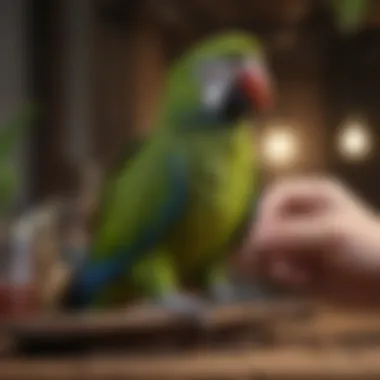
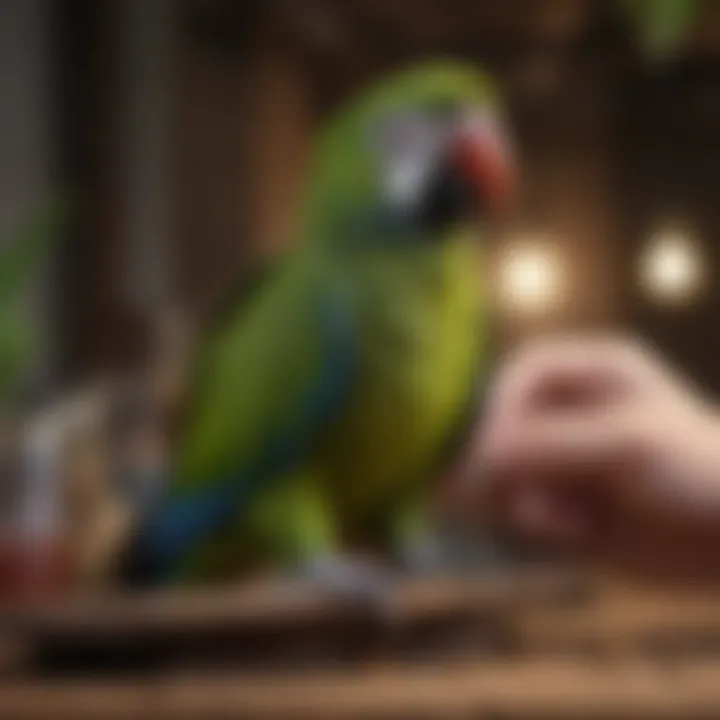
In addition to avian groomers, veterinarians also play a crucial role in nail care. They can provide hands-on services and offer guidance, especially during challenging situations. In complex cases, such as when a parrot has underlying health issues or unusual nail growth patterns, consulting a veterinarian is vital. They can diagnose any conditions affecting nail length or health, ensuring the parrot receives appropriate treatment.
Understanding when to seek help can save owners time and reduce stress. In summary, assistance from professionals should be considered when:
- The owner lacks experience or confidence in clipping nails.
- The parrot shows extreme distress during nail trimming.
- An underlying health issue is suspected.
- There is a need for specialized care or handling techniques.
By identifying these situations, pet owners can prioritize their birds' well-being and comfort, ensuring they receive the right level of care.
Identifying Qualified Avian Groomers
Finding the right avian groomer is critical for successful nail care. Qualified groomers should have specific expertise in handling parrots and other birds. Owners should look for groomers who have training in avian care and a history of working with different parrot species.
When searching for a qualified groomer, consider factors such as:
- Certifications: Look for professionals who have certifications from reputable avian organizations. This demonstrates a commitment to learning and understanding bird care.
- Experience: Experienced groomers are more familiar with various bird behaviors and can manage them effectively. Asking for references or checking reviews from previous clients can provide insight.
- Facility Environment: A clean, well-organized grooming space contributes to a stress-free experience for both birds and their owners.
It is also beneficial to have a walk-through of the facility before making a decision. Observe how the staff interacts with the birds. Assessing their comfort levels can help determine if the groomer will treat your parrot kindly and respectfully.
Veterinary Consultations and Nail Care
Veterinarians can offer valuable assistance in nail care and overall bird health. They can recommend a suitable course of action for specific grooming needs and provide thorough examinations when necessary.
During a veterinary appointment, the veterinarian can:
- Evaluate Overall Health: They can assess the parrot’s overall condition, ensuring that there are no underlying issues affecting nail growth or health.
- Provide Guidance: Vets can educate owners about proper nail maintenance at home and advise on the best practices for grooming.
- Offer Specialized Services: In cases where the bird's nails are severely overgrown or if there is a risk of injury, the vet can perform nail trims safely.
Pet owners should not hesitate to contact their veterinarian if they suspect any complications or are uncertain about their bird's grooming needs. Regular check-ups can help identify potential issues early, promoting a healthier and more satisfying life for the parrot. Understanding how and when to seek help is essential for effective avian care and building a solid foundation of trust between the bird and its owner.
Establishing a Regular Nail Care Routine
Establishing a regular nail care routine for your parrot is not just a recommendation; it is a vital aspect of ensuring your pet's health and well-being. Parrot nails grow continuously, and without timely clipping, they can lead to discomfort and other health issues. A routine schedule allows pet owners to monitor nail length effectively, avoiding overgrowth that can cause pain or injury.
The routine not only simplifies the nail care process but also helps in familiarizing your bird with handling. When birds are used to regular care, they usually experience less stress during the clipping process. It is beneficial for both the owner and the parrot to establish this practice early.
Frequency of Nail Clipping
The frequency at which you should clip your parrot's nails depends largely on the species, age, and activity level of your bird. Generally, smaller birds may require clipping every 4 to 6 weeks, while larger ones might need it every 6 to 8 weeks. Observing how quickly your bird's nails grow is crucial.
Key factors that influence nail growth include:
- Activity Level: Parrots that are more active often wear down their nails naturally.
- Diet: A healthy diet can affect nail strength and growth rates.
- Age: Young, growing birds may need more frequent trims than older birds.
Adjusting the clipping schedule based on these factors ensures that your parrot remains comfortable.
Incorporating Nail Care in Regular Grooming
Incorporating nail care into your parrot's regular grooming routine can be beneficial. It can transform nail clipping from a stressful event into a part of a comforting ritual. Set aside specific times for grooming sessions that include checking nails, along with cleaning feathers and checking overall health.
During grooming, observe your bird's behavior. This attention can uncover underlying issues that need addressing. Providing positive reinforcement, such as treats or praise, can help alleviate any anxiety your parrot associates with grooming.
Regular grooming not only benefits the nails, but enhances the bond between you and your parrot.
In summary, making nail care part of regular grooming creates a more comprehensive health management strategy for your parrot. This fosters a long-term commitment to both the aesthetic and physical health of your avian friend.
Ending on Nail Clipping Practices
Maintaining a consistent nail clipping schedule for your parrot is crucial for several reasons. It offers a direct impact on their overall health and enhances their quality of life. Clipping nails not only prevents painful overgrowth but also aids in facilitating better mobility. Healthy nails contribute to safe climbing, playing, and engaging in normal behavior.
Parrots naturally face the risk of various injuries from long nails. When nails become too long, they can tear or snag on surfaces, potentially leading to painful injuries or infections. Additionally, lengthy nails can hinder their ability to balance, causing falls that may result in further complications.
"A commitment to regular nail care ensures your parrot remains active and injury-free."
Moreover, nail clipping is a fundamental part of responsible pet ownership. It exemplifies a pet owner's dedication to their bird's welfare. By recognizing the signs of overgrowth and acting promptly, you show attentiveness that goes beyond basic care.
Reflecting on the Importance of Care
Caring for a parrot includes understanding their needs comprehensively, and nail clipping is an essential component. This practice not only protects the bird but also enhances the bond between the owner and the pet. Regular interaction during these sessions fosters trust. It helps your parrot become accustomed to handling, lowering stress when they visit a veterinarian for routine checks or emergencies.
Furthermore, a well-maintained parrot with trimmed nails has a cleaner living space. Overgrown nails can impact the cleanliness of cages, as they may scratch or damage perches, toys, and other furniture, leading to more cleanup for owners.
Encouragement for Long-Term Commitment
Ultimately, establishing a long-term commitment to parrot nail clipping reinforces a pattern of responsible pet ownership. Regular grooming is not just a one-time task; it should be a part of an overall maintenance routine. Parrots thrive on predictability, so finding a suitable schedule helps. You might consider setting reminders every four to six weeks, depending on your bird's growth rate.
To ensure consistent care, it can be helpful to integrate nail clipping into a broader grooming routine. Combine this trimming with bathing or cleaning activities to streamline the process.
Consider keeping a checklist of activities to ensure nothing is overlooked during routine care. Making it part of regular bonding time can also encourage acceptance of this essential task. Encouraging a positive outlook toward grooming leads to an easier experience for both the parrot and the owner.
For pet owners looking to deepen their practice, joining forums or groups on reddit.com or connecting on platforms like facebook.com can provide valuable insights and shared experiences.







